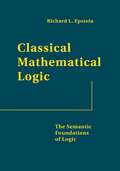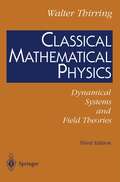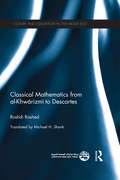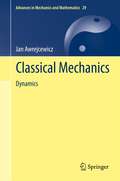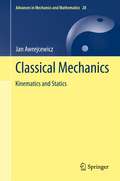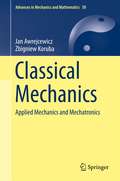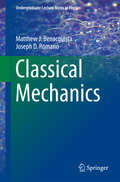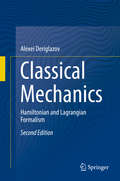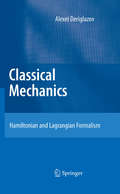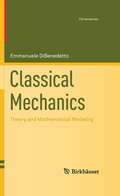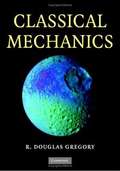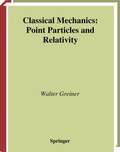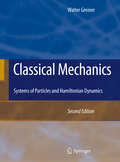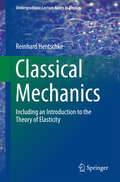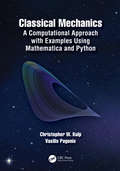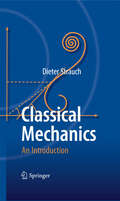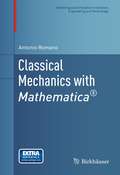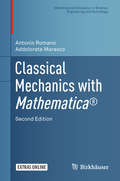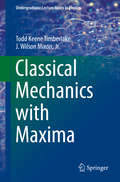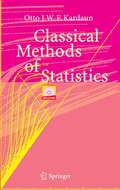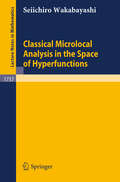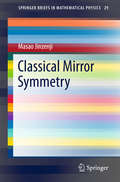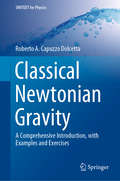- Table View
- List View
Classical Mathematical Logic: The Semantic Foundations of Logic (PDF)
by Richard L. Epstein Leslaw W. SzczerbaIn Classical Mathematical Logic, Richard L. Epstein relates the systems of mathematical logic to their original motivations to formalize reasoning in mathematics. The book also shows how mathematical logic can be used to formalize particular systems of mathematics. It sets out the formalization not only of arithmetic, but also of group theory, field theory, and linear orderings. These lead to the formalization of the real numbers and Euclidean plane geometry. The scope and limitations of modern logic are made clear in these formalizations. The book provides detailed explanations of all proofs and the insights behind the proofs, as well as detailed and nontrivial examples and problems. The book has more than 550 exercises. It can be used in advanced undergraduate or graduate courses and for self-study and reference. Classical Mathematical Logic presents a unified treatment of material that until now has been available only by consulting many different books and research articles, written with various notation systems and axiomatizations.
Classical Mathematical Physics: Dynamical Systems and Field Theories
by Walter ThirringThis book combines the enlarged and corrected editions of both volumes on classical physics stemming from Thirrings famous course. The treatment of classical dynamical systems uses analysis on manifolds to provide the mathematical setting for discussions of Hamiltonian systems, canonical transformations, constants of motion, and perturbation theory. Problems discussed include: nonrelativistic motion of particles and systems, relativistic motion in electromagnetic and gravitational fields, and the structure of black holes. The treatment of classical fields uses the language of differential geometry, treating both Maxwells and Einsteins equations in a compact and clear fashion. The book includes discussions of the electromagnetic field due to known charge distributions and in the presence of conductors, as well as a new section on gauge theories. It discusses the solutions of the Einstein equations for maximally symmetric spaces and spaces with maximally symmetric submanifolds, and concludes by applying these results to the life and death of stars. Numerous examples and accompanying remarks make this an ideal textbook.
Classical Mathematics from Al-Khwarizmi to Descartes (Culture and Civilization in the Middle East)
by Roshdi RashedThis book follows the development of classical mathematics and the relation between work done in the Arab and Islamic worlds and that undertaken by the likes of Descartes and Fermat. ‘Early modern,’ mathematics is a term widely used to refer to the mathematics which developed in the West during the sixteenth and seventeenth century. For many historians and philosophers this is the watershed which marks a radical departure from ‘classical mathematics,’ to more modern mathematics; heralding the arrival of algebra, geometrical algebra, and the mathematics of the continuous. In this book, Roshdi Rashed demonstrates that ‘early modern,’ mathematics is actually far more composite than previously assumed, with each branch having different traceable origins which span the millennium. Going back to the beginning of these parts, the aim of this book is to identify the concepts and practices of key figures in their development, thereby presenting a fuller reality of these mathematics. This book will be of interest to students and scholars specialising in Islamic science and mathematics, as well as to those with an interest in the more general history of science and mathematics and the transmission of ideas and culture.
Classical Mathematics from Al-Khwarizmi to Descartes (Culture and Civilization in the Middle East)
by Roshdi RashedThis book follows the development of classical mathematics and the relation between work done in the Arab and Islamic worlds and that undertaken by the likes of Descartes and Fermat. ‘Early modern,’ mathematics is a term widely used to refer to the mathematics which developed in the West during the sixteenth and seventeenth century. For many historians and philosophers this is the watershed which marks a radical departure from ‘classical mathematics,’ to more modern mathematics; heralding the arrival of algebra, geometrical algebra, and the mathematics of the continuous. In this book, Roshdi Rashed demonstrates that ‘early modern,’ mathematics is actually far more composite than previously assumed, with each branch having different traceable origins which span the millennium. Going back to the beginning of these parts, the aim of this book is to identify the concepts and practices of key figures in their development, thereby presenting a fuller reality of these mathematics. This book will be of interest to students and scholars specialising in Islamic science and mathematics, as well as to those with an interest in the more general history of science and mathematics and the transmission of ideas and culture.
Classical Mechanics: Dynamics (Advances in Mechanics and Mathematics #29)
by Jan AwrejcewiczThis is the second volume of three books devoted to Mechanics. In this book, dynamical and advanced mechanics problems are stated, illustrated, and discussed, including a few novel concepts in comparison to standard text books and monographs. Apart from being addressed to a wide spectrum of graduate students, postgraduate students, researchers, and teachers from the fields of mechanical and civil engineering, this volume is also intended to be used as a self-contained material for applied mathematicians and physical scientists and researchers.
Classical Mechanics: Kinematics and Statics (Advances in Mechanics and Mathematics #28)
by Jan AwrejcewiczThis is the first volume of three, devoted to Mechanics. This book contains classical mechanics problems including kinematics and statics. It is recommended as a supplementary textbook for undergraduate and graduate students from mechanical and civil engineering, as well as for physical scientists and engineers. It contains a basic introduction to classical mechanics, including fundamental principles, statics, and the geometry of masses, as well as thorough discussion on kinematics.
Classical Mechanics: Applied Mechanics and Mechatronics (Advances in Mechanics and Mathematics #30)
by Jan Awrejcewicz Zbigniew KorubaThis is the last book of three devoted to Mechanics, and uses the theoretical background presented in Classical Mechanics: Kinematics and Statics and Classical Mechanics: Dynamics. It focuses on exhibiting a unique approach, rooted in the classical mechanics, to study mechanical and electromagnetic processes occurring in Mechatronics. Contrary to the majority of the books devoted to Applied Mechanics, this volume places a particular emphasis on theory, modeling, analysis, and control of gyroscopic devices, including the military applications. This volume provides practicing mechanical/mechatronic engineers and designers, researchers, graduate and postgraduate students with a knowledge of mechanics focused directly on advanced applications.
Classical Mechanics (Undergraduate Lecture Notes in Physics)
by Matthew J. Benacquista Joseph D. RomanoThis textbook provides an introduction to classical mechanics at a level intermediate between the typical undergraduate and advanced graduate level. This text describes the background and tools for use in the fields of modern physics, such as quantum mechanics, astrophysics, particle physics, and relativity. Students who have had basic undergraduate classical mechanics or who have a good understanding of the mathematical methods of physics will benefit from this book.
Classical Mechanics: Hamiltonian and Lagrangian Formalism
by Alexei DeriglazovThe revised edition of this advanced textbook provides the reader with a solid grounding in the formalism of classical mechanics, underlying a number of powerful mathematical methods that are widely used in modern theoretical and mathematical physics. It reviews the fundamentals of Lagrangian and Hamiltonian mechanics, and goes on to cover related topics such as canonical transformations, integral invariants, potential motion in geometric setting, symmetries, the Noether theorem and systems with constraints. While in some cases the formalism is developed beyond the traditional level adopted in the standard textbooks on classical mechanics, only elementary mathematical methods are used in the exposition of the material.New material for the revised edition includes additional sections on the Euler-Lagrange equation, the Cartan two-form in Lagrangian theory, and Newtonian equations of motion in context of general relativity. Also new for this edition is the inclusion of problem sets and solutions to aid in the understanding of the material presented.The mathematical constructions involved are explicitly described and explained, so the book is a good starting point for the student new to this field. Where possible, intuitive motivations are replaced by explicit proofs and direct computations, preserving the level of rigor that makes the book useful for more advanced students intending to work in one of the branches of the vast field of theoretical physics. To illustrate how classical-mechanics formalism works in other branches of theoretical physics, examples related to electrodynamics, as well as to relativistic and quantum mechanics, are included.
Classical Mechanics: Hamiltonian and Lagrangian Formalism
by Alexei DeriglazovFormalism of classical mechanics underlies a number of powerful mathematical methods that are widely used in theoretical and mathematical physics. This book considers the basics facts of Lagrangian and Hamiltonian mechanics, as well as related topics, such as canonical transformations, integral invariants, potential motion in geometric setting, symmetries, the Noether theorem and systems with constraints. While in some cases the formalism is developed beyond the traditional level adopted in the standard textbooks on classical mechanics, only elementary mathematical methods are used in the exposition of the material. The mathematical constructions involved are explicitly described and explained, so the book can be a good starting point for the undergraduate student new to this field. At the same time and where possible, intuitive motivations are replaced by explicit proofs and direct computations, preserving the level of rigor that makes the book useful for the graduate students intending to work in one of the branches of the vast field of theoretical physics. To illustrate how classical-mechanics formalism works in other branches of theoretical physics, examples related to electrodynamics, as well as to relativistic and quantum mechanics, are included.
Classical Mechanics: Theory and Mathematical Modeling (Cornerstones)
by Emmanuele DiBenedetto* Offers a rigorous mathematical treatment of mechanics as a text or reference * Revisits beautiful classical material, including gyroscopes, precessions, spinning tops, effects of rotation of the Earth on gravity motions, and variational principles * Employs mathematics not only as a "unifying" language, but also to exemplify its role as a catalyst behind new concepts and discoveries
Classical Mechanics: An Undergraduate Text (PDF)
by R. Douglas GregoryGregory's Classical Mechanics is a major new textbook for undergraduates in mathematics and physics. It is a thorough, self-contained and highly readable account of a subject many students find difficult. The author's clear and systematic style promotes a good understanding of the subject: each concept is motivated and illustrated by worked examples, while problem sets provide plenty of practice for understanding and technique. Computer assisted problems, some suitable for projects, are also included. The book is structured to make learning the subject easy; there is a natural progression from core topics to more advanced ones and hard topics are treated with particular care. A theme of the book is the importance of conservation principles. These appear first in vectorial mechanics where they are proved and applied to problem solving. They reappear in analytical mechanics, where they are shown to be related to symmetries of the Lagrangian, culminating in Noether's theorem.
Classical Mechanics: Point Particles and Relativity (Classical Theoretical Physics)
by Walter GreinerIntended for advanced undergraduates and beginning graduate students, this text is based on the highly successful course given by Walter Greiner at the University of Frankfurt, Germany. The two volumes on classical mechanics provide not only a complete survey of the topic but also an enormous number of worked examples and problems to show students clearly how to apply the abstract principles to realistic problems.
Classical Mechanics: Including an Introduction to the Theory of Elasticity (Undergraduate Lecture Notes in Physics)
by Reinhard HentschkeThis textbook teaches classical mechanics as one of the foundations of physics. It describes the mechanical stability and motion in physical systems ranging from the molecular to the galactic scale. Aside from the standard topics of mechanics in the physics curriculum, this book includes an introduction to the theory of elasticity and its use in selected modern engineering applications, e.g. dynamic mechanical analysis of viscoelastic materials. The text also covers many aspects of numerical mechanics, ranging from the solution of ordinary differential equations, including molecular dynamics simulation of many particle systems, to the finite element method. Attendant Mathematica programs or parts thereof are provided in conjunction with selected examples. Numerous links allow the reader to connect to related subjects and research topics. Among others this includes statistical mechanics (separate chapter), quantum mechanics, space flight, galactic dynamics, friction, and vibration spectroscopy. An introductory chapter compiles all essential mathematical tools, ranging from coordinates to complex numbers. Completely solved problems and examples facilitate a thorough understanding of the material.
Classical Mechanics: A Computational Approach with Examples Using Mathematica and Python
by Christopher W. Kulp Vasilis PagonisClassical Mechanics: A Computational Approach with Examples using Python and Mathematica provides a unique, contemporary introduction to classical mechanics, with a focus on computational methods. In addition to providing clear and thorough coverage of key topics, this textbook includes integrated instructions and treatments of computation. Full of pedagogy, it contains both analytical and computational example problems within the body of each chapter. The example problems teach readers both analytical methods and how to use computer algebra systems and computer programming to solve problems in classical mechanics. End-of-chapter problems allow students to hone their skills in problem solving with and without the use of a computer. The methods presented in this book can then be used by students when solving problems in other fields both within and outside of physics. It is an ideal textbook for undergraduate students in physics, mathematics, and engineering studying classical mechanics. Features: Gives readers the "big picture" of classical mechanics and the importance of computation in the solution of problems in physics Numerous example problems using both analytical and computational methods, as well as explanations as to how and why specific techniques were used Online resources containing specific example codes to help students learn computational methods and write their own algorithms A solutions manual is available via the Routledge Instructor Hub and extra code is available via the Support Material tab
Classical Mechanics: A Computational Approach with Examples Using Mathematica and Python
by Christopher W. Kulp Vasilis PagonisClassical Mechanics: A Computational Approach with Examples using Python and Mathematica provides a unique, contemporary introduction to classical mechanics, with a focus on computational methods. In addition to providing clear and thorough coverage of key topics, this textbook includes integrated instructions and treatments of computation. Full of pedagogy, it contains both analytical and computational example problems within the body of each chapter. The example problems teach readers both analytical methods and how to use computer algebra systems and computer programming to solve problems in classical mechanics. End-of-chapter problems allow students to hone their skills in problem solving with and without the use of a computer. The methods presented in this book can then be used by students when solving problems in other fields both within and outside of physics. It is an ideal textbook for undergraduate students in physics, mathematics, and engineering studying classical mechanics. Features: Gives readers the "big picture" of classical mechanics and the importance of computation in the solution of problems in physics Numerous example problems using both analytical and computational methods, as well as explanations as to how and why specific techniques were used Online resources containing specific example codes to help students learn computational methods and write their own algorithms A solutions manual is available via the Routledge Instructor Hub and extra code is available via the Support Material tab
Classical Mechanics: An Introduction
by Dieter StrauchThis upper-level undergraduate and beginning graduate textbook primarily covers the theory and application of Newtonian and Lagrangian, but also of Hamiltonian mechanics. In addition, included are elements of continuum mechanics and the accompanying classical field theory, wherein four-vector notation is introduced without explicit reference to special relativity. The author's writing style attempts to ease students through the primary and secondary results, thus building a solid foundation for understanding applications. Numerous examples illustrate the material and often present alternative approaches to the final results.
Classical Mechanics with Mathematica® (Modeling and Simulation in Science, Engineering and Technology)
by Antonio RomanoThis textbook takes a broad yet thorough approach to mechanics, aimed at bridging the gap between classical analytic and modern differential geometric approaches to the subject. Developed by the author from 35 years of teaching experience, the presentation is designed to give students an overview of the many different models used through the history of the field—from Newton to Lagrange—while also painting a clear picture of the most modern developments. Throughout, it makes heavy use of the powerful tools offered by Mathematica. The volume is organized into two parts. The first focuses on developing the mathematical framework of linear algebra and differential geometry necessary for the remainder of the book. Topics covered include tensor algebra, Euclidean and symplectic vector spaces, differential manifolds, and absolute differential calculus. The second part of the book applies these topics to kinematics, rigid body dynamics, Lagrangian and Hamiltonian dynamics, Hamilton–Jacobi theory, completely integrable systems, statistical mechanics of equilibrium, and impulsive dynamics, among others.Unique in its scope of coverage and method of approach, Classical Mechanics will be a very useful resource for graduate students and advanced undergraduates in applied mathematics and physics who hope to gain a deeper understanding of mechanics.
Classical Mechanics with Mathematica® (Modeling and Simulation in Science, Engineering and Technology)
by Antonio Romano Addolorata MarascoThis textbook takes a broad yet thorough approach to mechanics, aimed at bridging the gap between classical analytic and modern differential geometric approaches to the subject. Developed by the authors from over 30 years of teaching experience, the presentation is designed to give students an overview of the many different models used through the history of the field—from Newton to Hamilton—while also painting a clear picture of the most modern developments. The text is organized into two parts. The first focuses on developing the mathematical framework of linear algebra and differential geometry necessary for the remainder of the book. Topics covered include tensor algebra, Euclidean and symplectic vector spaces, differential manifolds, and absolute differential calculus. The second part of the book applies these topics to kinematics, rigid body dynamics, Lagrangian and Hamiltonian dynamics, Hamilton–Jacobi theory, completely integrable systems, statistical mechanics of equilibrium, and impulsive dynamics, among others. This new edition has been completely revised and updated and now includes almost 200 exercises, as well as new chapters on celestial mechanics, one-dimensional continuous systems, and variational calculus with applications. Several Mathematica® notebooks are available to download that will further aid students in their understanding of some of the more difficult material. Unique in its scope of coverage and method of approach, Classical Mechanics with Mathematica® will be useful resource for graduate students and advanced undergraduates in applied mathematics and physics who hope to gain a deeper understanding of mechanics.
Classical Mechanics with Maxima (Undergraduate Lecture Notes in Physics)
by Todd Keene Timberlake J. Wilson MixonThis book guides undergraduate students in the use of Maxima—a computer algebra system—in solving problems in classical mechanics. It functions well as a supplement to a typical classical mechanics textbook. When it comes to problems that are too difficult to solve by hand, computer algebra systems that can perform symbolic mathematical manipulations are a valuable tool. Maxima is particularly attractive in that it is open-source, multiple-platform software that students can download and install free of charge. Lessons learned and capabilities developed using Maxima are easily transferred to other, proprietary software.
Classical Methods of Statistics: With Applications in Fusion-Oriented Plasma Physics
by Otto J.W.F. KardaunClassical Methods of Statistics is a guidebook combining theory and practical methods. It is especially conceived for graduate students and scientists who are interested in the applications of statistical methods to plasma physics. Thus it provides also concise information on experimental aspects of fusion-oriented plasma physics. In view of the first three basic chapters it can be fruitfully used by students majoring in probability theory and statistics. The first part deals with the mathematical foundation and framework of the subject. Some attention is given to the historical background. Exercises are added to help readers understand the underlying concepts. In the second part, two major case studies are presented which exemplify the areas of discriminant analysis and multivariate profile analysis, respectively. To introduce these case studies, an outline is provided of the context of magnetic plasma fusion research. In the third part an overview is given of statistical software; separate attention is devoted to SAS and S-PLUS. The final chapter presents several datasets and gives a description of their physical setting. Most of these datasets were assembled at the ASDEX Upgrade Tokamak. All of them are accompanied by exercises in form of guided (minor) case studies. The book concludes with translations of key concepts into several languages.
Classical Microlocal Analysis in the Space of Hyperfunctions (Lecture Notes in Mathematics #1737)
by Seiichiro WakabayashiThe book develops "Classical Microlocal Analysis" in the spaces of hyperfunctions and microfunctions, which makes it possible to apply the methods in the distribution category to the studies on partial differential equations in the hyperfunction category. Here "Classical Microlocal Analysis" means that it does not use "Algebraic Analysis." The main tool in the text is, in some sense, integration by parts. The studies on microlocal uniqueness, analytic hypoellipticity and local solvability are reduced to the problems to derive energy estimates (or a priori estimates). The author assumes basic understanding of theory of pseudodifferential operators in the distribution category.
Classical Mirror Symmetry (SpringerBriefs in Mathematical Physics #29)
by Masao JinzenjiThis book furnishes a brief introduction to classical mirror symmetry, a term that denotes the process of computing Gromov–Witten invariants of a Calabi–Yau threefold by using the Picard–Fuchs differential equation of period integrals of its mirror Calabi–Yau threefold. The book concentrates on the best-known example, the quintic hypersurface in 4-dimensional projective space, and its mirror manifold.First, there is a brief review of the process of discovery of mirror symmetry and the striking result proposed in the celebrated paper by Candelas and his collaborators. Next, some elementary results of complex manifolds and Chern classes needed for study of mirror symmetry are explained. Then the topological sigma models, the A-model and the B-model, are introduced. The classical mirror symmetry hypothesis is explained as the equivalence between the correlation function of the A-model of a quintic hyper-surface and that of the B-model of its mirror manifold.On the B-model side, the process of construction of a pair of mirror Calabi–Yau threefold using toric geometry is briefly explained. Also given are detailed explanations of the derivation of the Picard–Fuchs differential equation of the period integrals and on the process of deriving the instanton expansion of the A-model Yukawa coupling based on the mirror symmetry hypothesis.On the A-model side, the moduli space of degree d quasimaps from CP^1 with two marked points to CP^4 is introduced, with reconstruction of the period integrals used in the B-model side as generating functions of the intersection numbers of the moduli space. Lastly, a mathematical justification for the process of the B-model computation from the point of view of the geometry of the moduli space of quasimaps is given.The style of description is between that of mathematics and physics, with the assumption that readers have standard graduate student backgrounds in both disciplines.
Classical Newtonian Gravity: A Comprehensive Introduction, with Examples and Exercises (UNITEXT for Physics)
by Roberto A. Capuzzo DolcettaThis textbook offers a readily comprehensible introduction to classical Newtonian gravitation, which is fundamental for an understanding of classical mechanics and is particularly relevant to Astrophysics. The opening chapter recalls essential elements of vectorial calculus, especially to provide the formalism used in subsequent chapters. In chapter two Classical Newtonian gravity theory for one point mass and for a generic number N of point masses is then presented and discussed. The theory for point masses is naturally extended to the continuous case. The third chapter addresses the paradigmatic case of spherical symmetry in the mass density distribution (central force), with introduction of the useful tool of qualitative treatment of motion. Subsequent chapters discuss the general case of non-symmetric mass density distribution and develop classical potential theory, with elements of harmonic theory, which is essential to understand the potential development in series of the gravitational potential, the subject of the fourth chapter. Finally, in the last chapter the specific case of motion of a satellite around the earth is considered. Examples and exercises are presented throughout the book to clarify aspects of the theory. The book is aimed at those who wish to progress further beyond an initial bachelor degree, onward to a master degree, and a PhD. It is also a valuable resource for postgraduates and active researchers in the field.
